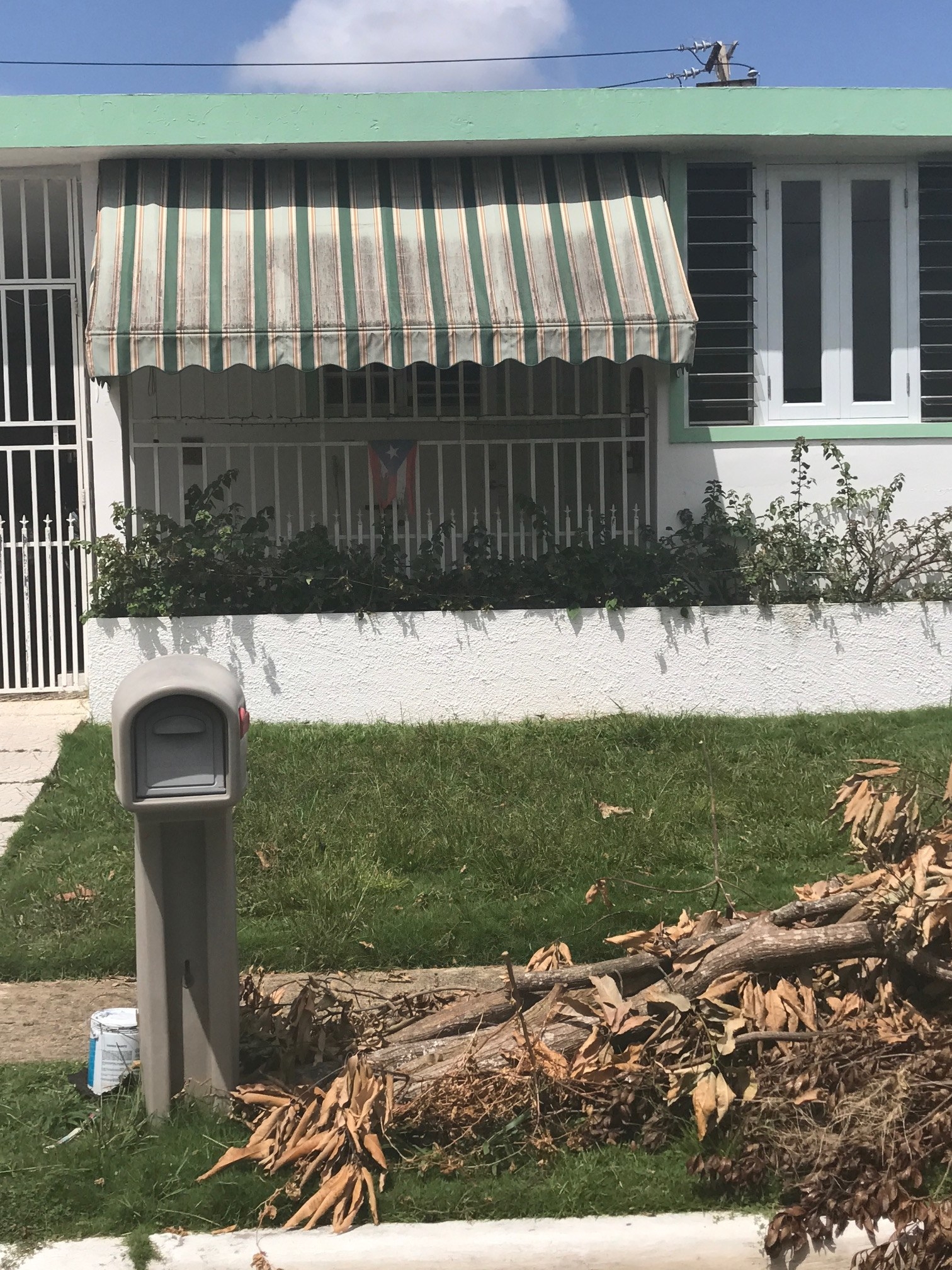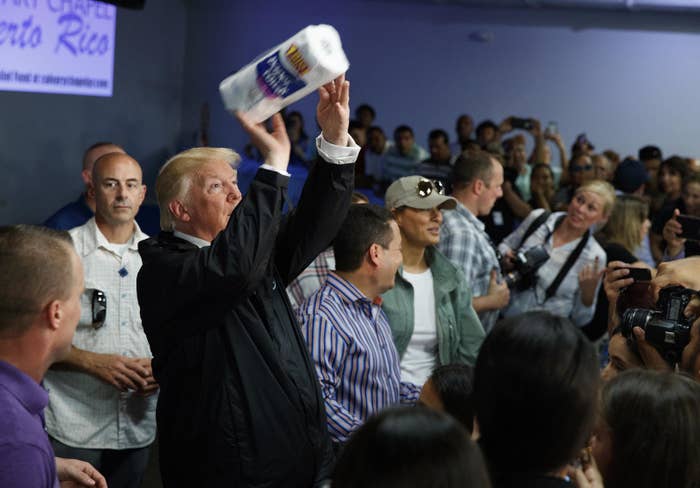
As soon as President Trump stepped off Air Force One at Muñiz Air National Guard Base this week — greeted by a sign that read "TRUMP: Welcome to Puerto Rico" and "We are one," flanked by American and Puerto Rican flags on each side — the goals of the trip were set for both the president and desperate Puerto Rican officials.
Trump needed the trip to go well and to be told everything was going great on the storm-stricken island, after hearing days of criticism of the federal response to Hurricane Maria. Most of his comments during his tour of the island Tuesday were variations on two sentiments: FEMA, the military, the federal government — so, Donald Trump — were doing a terrific job despite unprecedented challenges. And, Trump kept saying, Puerto Rican officials (except for one pesky mayor) were saying that the Trump administration was doing a fantastic job, and Americans on and off the island should really listen to what they have to say.
Puerto Rican officials, meanwhile, needed the president to feel welcomed. They needed him to see Puerto Ricans as Americans and to leave the island happy with his interactions with government officials and residents dealing with a crisis. Because they've seen how far praising the president can go in sustaining his attention on, and generosity toward, a situation still in dire need of help.
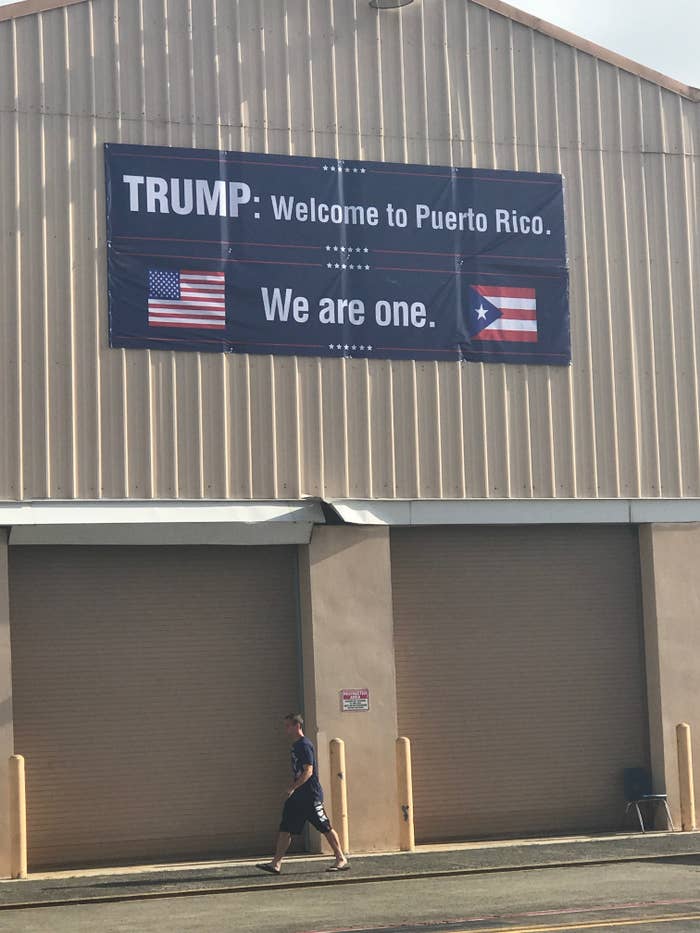
I was the press pool reporter for the trip, responsible for sending reports to hundreds of reporters around the country. And I am, as far as I know, the only White House press corps reporter of Puerto Rican descent. The trip meant a lot to me. I wanted to capture as faithfully as I could what was happening during the visit, but also what the president's actions and words meant for the island and its struggling residents going forward.
In the brief tour, a picture emerged of a president who was very happy with the events of the day ("It was a great, great visit," he would say later on Air Force One) but also of a leader who will be measured not by well-staged photo ops with friendly residents and excited members of a church, but by what he does next to help the 3.5 million US citizens relying on him to lift up a flattened island.
The tone for the day was set at the first stop — a briefing with FEMA, military, and Puerto Rican officials, where Trump playfully told everyone assembled that FEMA administrator Brock Long was going through a lot, as after receiving A+ grades for his response to hurricanes in Florida and Texas, he immediately had to deal with the unique challenges of category 5 Hurricane Maria. Trump thanked Puerto Rico Gov. Ricardo Rosselló, who he noted "is not even from my party," before literally saying to Congresswoman Jenniffer González-Colón that she should repeat some of the nice things she has said about the federal response in front of the assembled media.
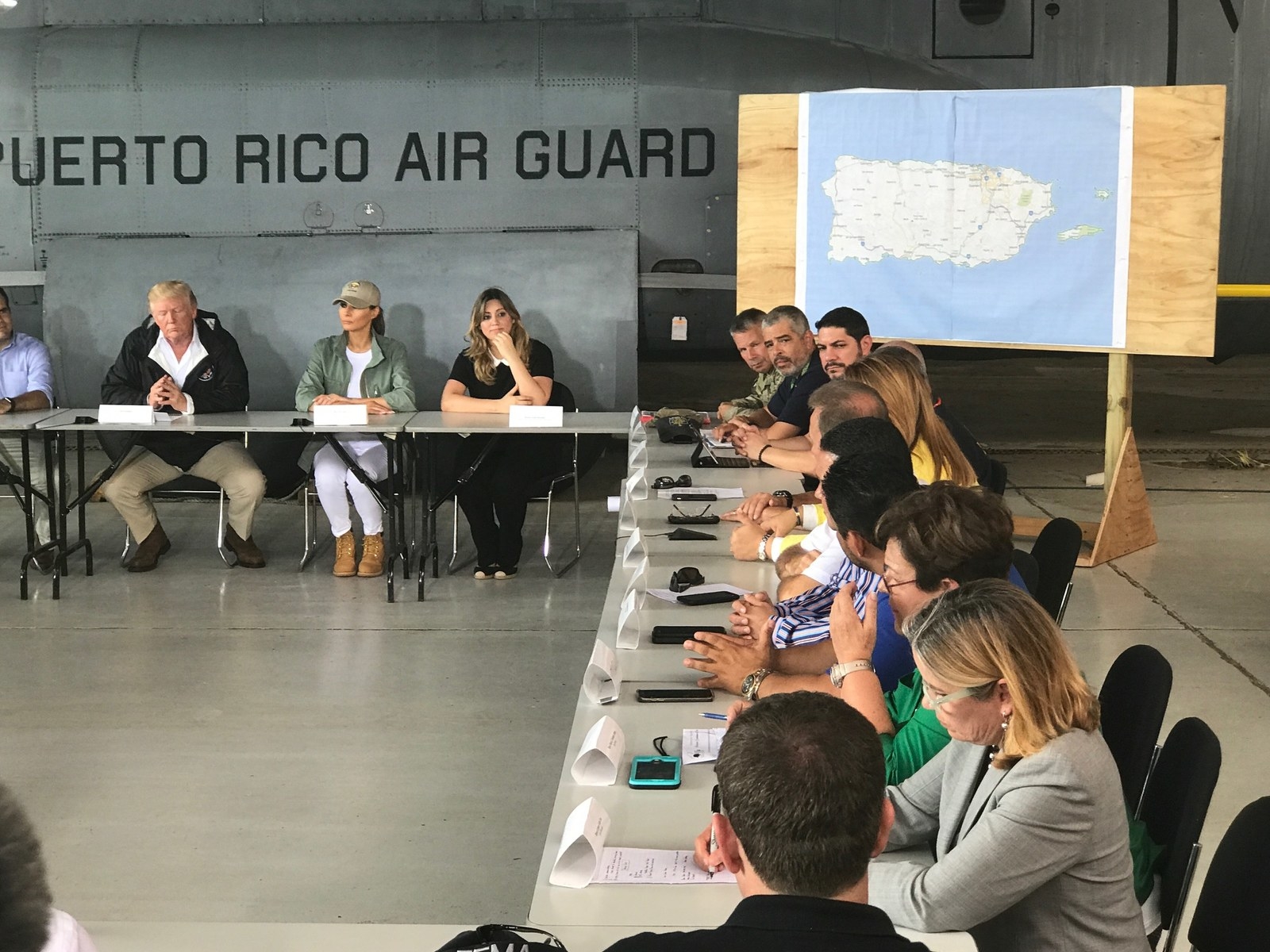
Trump has a steadfast ally in González-Colón, and she proved it at the briefing, saying "never before" has the island had this level of communication with the federal government. Trump called her "generous," for her comments.
But not a word was heard from San Juan Mayor Carmen Yulín Cruz, who Trump had attacked on Twitter over the weekend for criticizing his response to Maria. The two briefly exchanged pleasantries before the briefing, but when González-Colón's comments reached their crescendo and most of the assembled crowd applauded for the federal and military response, Yulín Cruz kept her hands clasped in front of her, refusing to join in. It was only after the cameras left and cabinet members had a meeting closed to the press that she was allowed to participate, becoming animated and vocal, according to a source in the room.
"Saving lives matters, we have to keep our focus on preventing deaths," was the message she gave the president when they spoke briefly, said the source who spoke to her.
Later, Yulín Cruz would tell reporters she was upset when Trump said at the briefing that Puerto Rico "threw our budget a little out of whack, but that's fine," calling him the "miscommunicator in chief."
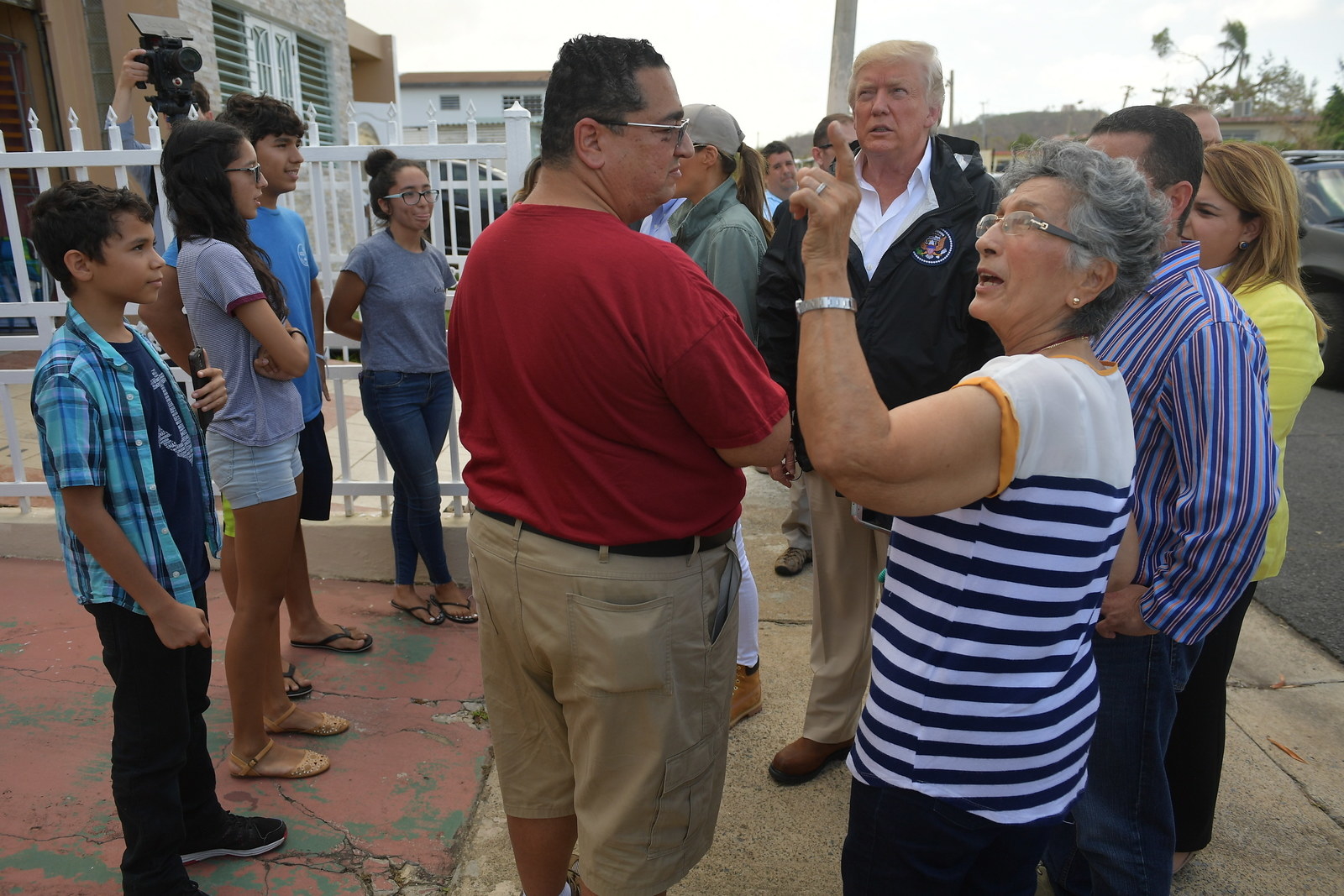
But those sorts of comments were largely away from public view during Trump's tour. The president's advance staff, tasked with ensuring that what the press saw and sent out of Puerto Rico was positive for the president, largely succeeded, at least when Trump stuck to the script.
Against the backdrop of an 86-degree cloudy day, the president's motorcade passed broken highway dividers and hundreds of downed trees on the way to a walking tour. One woman held up a sign reading "You are a bad hombre" as Trump arrived outside Guaynabo, where the concrete homes were mostly intact. As the pool reporter, I was the only reporter allowed to join the press photographers and get close enough to hear what the president said to the families he met in the neighborhood.
Walking with first lady Melania Trump, Rosselló, and Puerto Rico first lady Beatriz Rosselló, the president told a family "we're going to help you out," and though he was criticized for choosing a middle-class neighborhood with concrete homes rather than an area with more devastated wood homes, the response on the ground was warm. A man peeking over a fence with his son to get a better look at the commotion answered my question on if he was happy the president came.
"Yes, of course," he said, before piquing the interest of a Secret Service agent who tapped his pocket to make sure he didn't have a weapon. "It's the first time I have the president so close to me."
Most people on the island didn't see the president, but many of those who did appreciated that he came and thanked him for his visit.
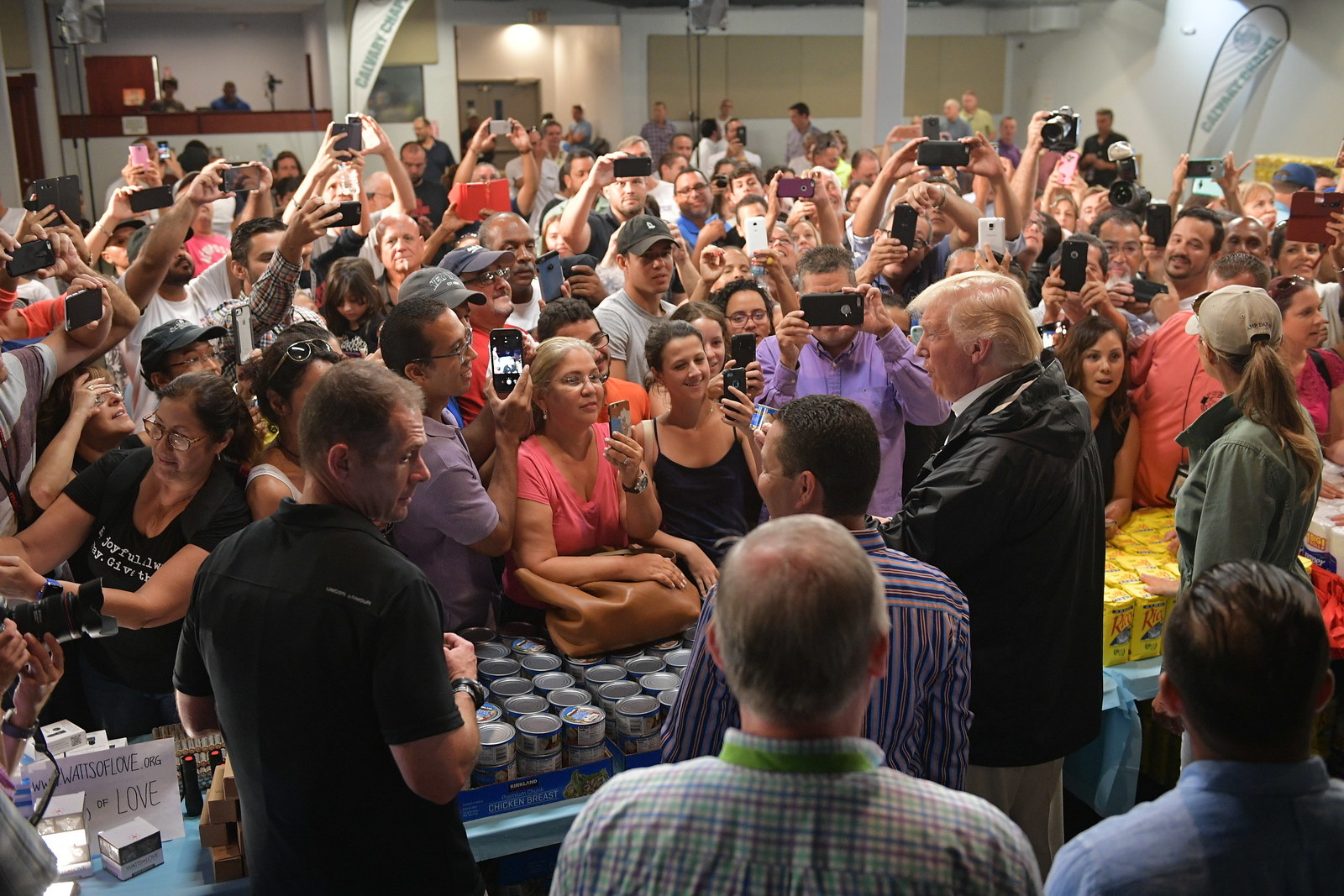
Trump's next stop, at evangelical Calvary Chapel, also started on sound footing for Trump and Puerto Rican officials. Before walking in, Rosselló again said he was "grateful" for the president and the federal government. Inside, a friendly church crowd, with congregants both distributing and receiving aid, threw up a big cheer for Trump and jockeyed to take pictures of him and the first lady.
"There's a lot of love in this room, a lot of love," Trump said, pleased.
Before Tuesday, Puerto Rican officials involved in the planning of Trump's visit told me there were plans to evoke camera-friendly images from Houston after Hurricane Harvey of an at-ease Trump mingling with local residents, posing for selfies, and handing out food and supplies. With cans of food and bags of rice in front of him, that plan looked ready to go into action. But in a surreal moment, the president did his best Stephen Curry impersonation and began softly shooting paper towel rolls into the confused but smitten crowd.
Trump, who was intrigued by cans of chicken, handed out flashlights as well. “Flashlights, you don’t need ’em anymore. You don’t need ’em anymore,” he said.
The images and video were easy fodder for critics on social media, where people were both taken aback by Trump's cavalier style and quick to note that the vast majority of the island is still without power, and likely in need of flashlights. Trump himself addressed some of the criticism hours later, tweeting that there were "so many Fake News stories today. No matter what I do or say, they will not write or speak truth."
Trump is throwing paper towels into a crowd in Puerto Rico. This is gross. We deserve an actual leader. https://t.co/vTwW8vJGGE
Trump would get the optics he wanted at his next stop, surveying hurricane damage in a helicopter before landing on aircraft carrier the USS Kearsarge for briefings with the governors of the US Virgin Islands and Puerto Rico, as well as military officials. The White House eventually cut that leg of the trip into a video, complete with a soaring musical score. Despite reports that the US Virgin Islands are inundated with trash, their governor, Kenneth Mapp, also praised Trump. "Because of your commitment, Mr. President, we're talking about opening schools and welcoming cruise ships back," he said.
After more pomp and circumstance, with servicemen and women lined up to see Trump off, the president headed back to Air Force One, where González-Colón spoke about what comes next.
She said the president asked her what the island needs, and said "you're not alone." She said House Speaker Paul Ryan told her a supplemental aid package, which the White House would formally request the next day, would be dealt with at the end of October to provide the funds needed to get Puerto Rico back on its feet. While Trump had already signed a FEMA waiver providing funds for emergency rescue and removal operations and $40 million for highways, she said she has talked to the secretaries of transportation and agriculture about what other programs can be waived to help.
Asked on Air Force One if he heard constructive criticism in Puerto Rico, Trump said, "Honestly, I heard none," adding that he only heard thank-you's.
"I know the people of Puerto Rico, and I know Puerto Rican people that live in New York, and they are friends of mine," he said. "And I will tell you it's an honor for me to have done it."
But as soon as Trump's plane left the island, the limits of a manufactured, feel-good trip came into focus.
Two parts of the day showed how much of a challenge Puerto Rican officials still face, even as they generally made it through the day unscathed, sending the president home happy.
In an interview with Fox News from Puerto Rico, an upbeat Trump sounded the kind of populist, make-the-people-in-front-of-you-happy comment he might have made to local residents during the campaign. Puerto Rico "can say goodbye" to its debt, Trump said. “They owe a lot of money to your friends on Wall Street and we’re going to have to wipe that out,” he told interviewer Geraldo Rivera.
But on Wednesday, Trump's budget director Mick Mulvaney put the car in reverse, suggesting that people shouldn't take Trump "word for word" on the subject.
"This was a very badly mismanaged island for a very long time," he said in a morning TV interview. "And I think what you saw the president talking about was his acknowledgment that Puerto Rico is going to have to figure out a way to solve that debt problem in order to fix itself going forward."
And during the hangar briefing, Trump unknowingly walked Rosselló into a controversy he would have rather avoided, one that has animated activists and journalists on the island. Asked how many people have died as a result of Hurricane Maria, Rosselló said the answer was 16, to the chagrin of critics who questioned the official tally. After Trump was clear of the island, the official government death count was updated to 34.
Trump got what he wanted out of his visit to Puerto Rico, before going off to focus on another tragedy on the mainland. Now Puerto Rico will have to wait to see if it gets what it needs.
During the president's walking tour, a resident told him their electricity had already been down since Hurricane Irma grazed the island.
"You always come back," Trump said.
"Puerto Rico is Puerto Rico," the resident answered, leaving the question of how much Trump can do to alter its fate to hang in the air.
